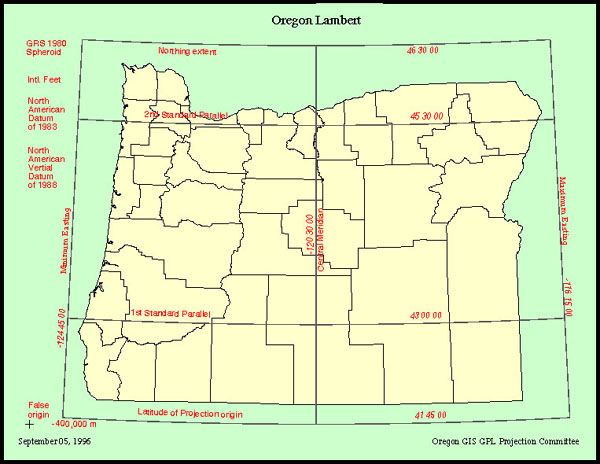| Oregon Coordinate Reference System Standard |
|
|
 |
| Oregon Lambert |
|
Ten different major map
projections have been commonly used in Oregon, and
all have varied error across the state. A common
projection for data display, analysis, publishing and
transfer is needed. The Oregon Geographic Information Council
(OGIC) endorsed the use of Oregon Lambert as a standard
for state agencies.
Oregon Lambert is
recognized by the European Petroleum Survey Group which
maintains and publishes an international coordinate
reference system database.
|
- Total area error for the state is 0.0045% (2,900
acres out of 64 million).
- Average length error for the state is 0.0176%
(1.76 in 10,000).
- Error in distance measurement may be as
high as 0.053% (5.3 in 10,000).
|
| COORDINATE REFERENCE SYSTEM
DESCRIPTION |
Projection
|
LAMBERT CONIC
CONFORMAL
|
Datum
|
NAD83
|
Units
|
INTERNATIONAL FEET,
3.28084
(.3048 Meters)
|
Spheroid
|
GRS1980
|
|
Parameters |
1st Standard
Parallel
|
43 00
0.000
|
2nd Standard Parallel
|
45 30 0.000
|
Central Meridian
|
-120 30 0.000
|
Latitude of Projection's
Origin
|
41 45 0.000
|
False Easting
|
400,000.00000
Meters
(1,312,335.958 Feet)
|
False Northing
|
0.00000 Meters
|
Notes: US
Survey foot = 1200/3937 meters (0.3048006096
m)
International foot = 0.3048 m exactly, 1 meter =
3.28084 Intl.
feet
|

|
| Oregon Lambert History |
|
| Oregon GIS Program Leaders (GPL) formed
a committee to evaluate and recommend a common
projection for data display, analysis, publishing and
transfer for Oregon. The committee was
comprised of representatives from the DAS/IRMD
Geospatial Enterprise Office (SSCGIS), the Oregon
Department of Transportation (ODOT), the Oregon
Department of Forestry (ODF), the Oregon Department of
Environmental Quality (DEQ), and the Oregon Department
of Geology and Mineral Industries (DOGAMI). |
Additionally, other organizations within the state
were consulted. The committee reviewed projections
in use, compared how neighboring states deal with
similar issues, and calculated projection errors.
They submitted a recommended standard, Oregon
Lambert, to the Oregon Geographic Information Council
(OGIC) who endorsed the standard for use by state
agencies. | Recommendations:
- Projection metadata accompany all spatial data transfers
for Oregon agencies.
- Spatial data published by Oregon agencies use the
adopted standard, Oregon Lambert.
|
| Oregon Lambert Methodology |
|
The total change
in latitude for the state was calculated and then the
standard parallels were set at 1/6th of the change north
of the minimum and 1/6th of the change south of the
maximum. The final values for the standard parallels
were rounded to even or half degrees. The central
meridian was set at 120 degrees 30', the mid point east
to west of the state. The origin was shifted 400,000
meters to the west to put the entire state in the
positive quadrant.
Error
statistics (pdf)
Minimum, maximum, and mean
percentage errors for each map projection. |
Images Showing
Calculated Percentage Error
These maps were
created from error statistic calculations based on
formulas in Map Projections- A Working Manual by
John Snyder, USGS Professional Paper 1385, 1987. Each
"cell" is a 7.5' USGS quad.
Polygon
error (gif) Oregon Lambert, NAD83, Intl.
Ft
Polygon
error (gif) US Lambert, NAD27, Meters
Length
error (gif) US Lambert, NAD27, Meters
Polygon
error (gif) State Plane North Zone, NAD83, Intl.
Ft
Length
error (gif) State Plane North Zone, NAD83, Intl.
Ft
Length
error (gif) UTM Zone 10, NAD83, Meters
Polygon
error (gif) Oregon Albers, NAD83, Meters
Length
error (gif) Oregon Albers, NAD83,
Meters
|
|
|
|
| |
|